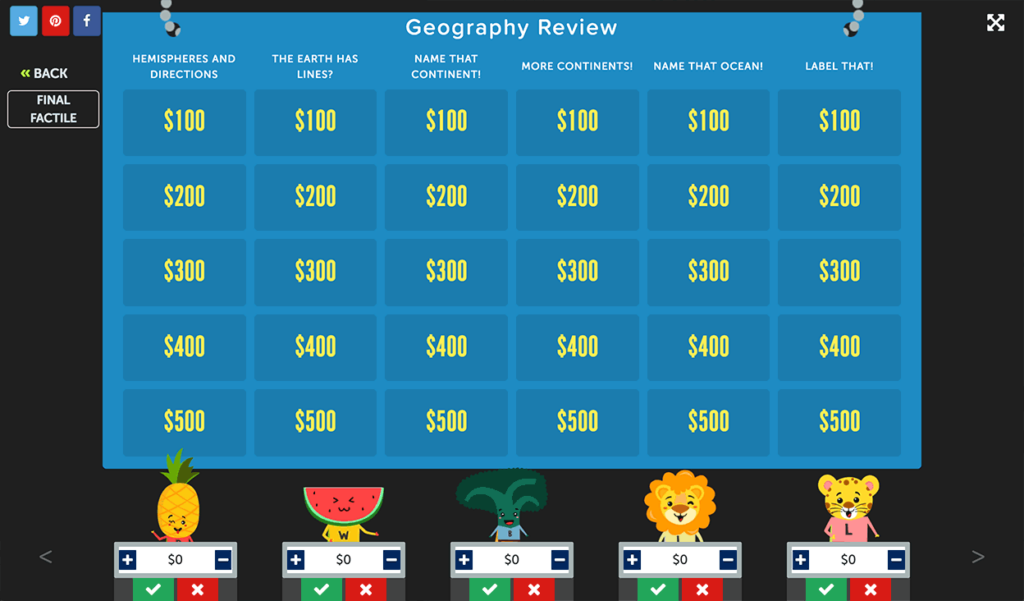Written by Kellie Ferguson, Instructional Designer, and Lexi Schlosser, Faculty Developer of Online Learning
In the second part of our gamification blog series, we are going to explore some easy, low-tech ways to incorporate gamification and game-based learning into your own course. If gamification is brand new to you, check out the first blog in our series for a general overview and introduction.
To get started, one of the first questions to consider is: how often do you want to use games as a part of your class?
If you are looking to mix-up assignments here and there to reinforce or re-engage students with specific course concepts, think about single activities that you can transform into a game. If you are interested in developing more complex storylines or utilizing higher-tech tools, keep an eye out for Part 3 of our Gamification Blog Series!
One way to introduce gamification into your course is by gamifying individual activities or assessments. This can be done by creating mini competitions out of assessment activities or using a low-stakes assessment in your course as a place for students to “level up,” earn points, or “unlock” a new element of the course. For example, as you are asking your students to complete knowledge checks as formative assessments, you might provide them with gold coins to collect throughout the course. Each gold coin can represent a stronger understanding of the course content. By the end of the quarter, the gold coins (even digital ones) can be turned in to receive a helpful resource for the final, like a bonus study quiz or study guide, extra credit, or another fun element of surprise.
When deciding what assignments you want to try gamifying, make sure students first understand the purpose of the activity by defining the learning objectives and goals the activity is designed to achieve. Then, think about ways you can encourage friendly competition, reward achievements, and integrate in fun activities that achieve the set learning objectives of your course. Are you ready to get started?
Let's explore ways that easy-to-use technologies can be incorporated to create game-like activities
Educational technology can be an engaging way to facilitate student activities, collaborative learning, and even assessment. The curve to learning new technologies can vary per person. The OTL Ed-Tech Knowledge Base includes research and resources oriented around popular tools to help with the learning curve. Additionally, when choosing the right tool for your teaching, you always want to be aware of any limitations regarding cost, accessibility, functionality, and the student learning curve.
Interactive Quizzing
Kahoot! Is an online software that promotes engagement by facilitating real-time quizzing games. You can use it to introduce new course topics or assess learning in a low-stakes and interactive way. For instance, before beginning a challenging lesson on medical terminology, you might introduce a Kahoot! Game to gauge students’ understanding. This would help you know what content to pay extra attention to or where you might need to find supplemental resources to better support students through their learning. Although it is typically used in face-to-face courses, you can even explore self-paced mini challenges for students to explore independently.
Jeopardy-Style Games
One of the more common ways to gamify a class activity might be through a game of jeopardy. Factile (formerly Playfactile) is an online platform used to create jeopardy-style games. This tool works for face-to-face courses as well as asynchronous online courses. For various STEM courses, Factile allows for math equations using LaTeX formatting and comes with thousands of templates to choose from. Students might enjoy a fun way to prepare for their upcoming math midterm or use it to refresh their understanding before the final exam. The image below provides an example of a jeopardy-style game for a Geography course.
Video Discussions
Flip (formerly Flip Grid) is a video discussion platform that can help facilitate dynamic and engaging online discussions. Flip integrates with Canvas for seamless introduction to your course. One low maintenance way to gamify an activity with Flip might be to send your students on a scavenger hunt, whether digitally or on campus, and ask them to share 1-minute video clip updates along their journey. This might work well in a language course where students are instructed to order food in the language they are learning. It might also work well in an engineering course where students are tasked with observing a construction site on campus. For more creative ways instructors are exploring Flip in college courses, check out the #gridgames webpage.
Low-Stakes Learning Games
Flippity is a game-based learning tool that allows instructors to create content using Google sheets. With Flippity, a variety of different games can be created from the same information or set of data. So, for instance, language learners might use Flippity to play a word search game, then switch to Bingo as they commit a set of words and definitions to memory. Or students who need to memorize lots of terms can use memory games and flashcards to test their understanding. Tournaments can be easily set up within Flippity, adding a competitive edge to study sessions or low-stakes class assessments. The image below shows four of the many game-like options available with Flippity.
Perhaps you want to explore gamification without the added stress of learning and using a new technology
One simple way to re-frame your course to align with gamification might involve naming ‘tasks’ or ‘activities’ for students to complete as ‘challenges,’ ‘quests,’ or ‘missions.’ Adding collaborative learning opportunities to these missions would also incorporate an element of teamwork and help students recognize that they should be playing this game together. To take this a step further, you might have these mini missions align with an overall theme, or narrative. This narrative can be infused throughout the course by including references, images, videos, and language that fits within the narrative.
For example, a communications course might be designed around sending students on a treasure hunt, looking to find skills and gain knowledge about public speaking. The goal of the course (or learning outcome) is for students to become confident and excited about public speaking. The theme of a treasure hunt will help them reach that goal by engaging them in mini quests to complete (collaboratively and independently), collecting gold coins along the way to turn in before their final presentation in the course, which highlights their salient learning experiences. Could this course be taught without sending students on a treasure hunt of activities and lessons? Sure! Could the quests for more knowledge, collection of gold coins, and overall narrative increase their motivation to learn? Potentially so!
As you consider ways you can build a quest out of your course, one of the first and simplest steps is to create a theme and change some basic course elements to fit within that theme. Take a look at your own course: maybe you begin with the addition of a theme/narrative, maybe you begin with one low-stakes activity, or maybe you want to check out the next blog in our series for high-tech ways to gamify your course.
Tips to Get Started:
- Look at your learning activities and course learning outcomes. What activities might benefit from using game elements? Perhaps you begin with your introduction discussion board in Canvas. Students can select and share their game avatar to be used and referenced throughout additional activities in the course. What might those additional activities look like?
- Think about the tech you and your students have access to, and how you can leverage some of these ed-tech tools to gamify different activities in your course. Are there additional uses of technology that students can engage with asynchronously as they learn new course content?
- Consider student engagement throughout your course. If you have taught the course previously, are there times in the term or places in the material where you notice engagement wanes or students struggle to understand and absorb concepts? These might be places to consider bringing in gamified activities!
- Are you using groups or other collaborative based learning opportunities? How might gamified elements aid in group work? How might you prepare students to collaborate within a gamified course?
- Do you want additional support with getting started? Schedule a consultation with an Instructional Designer in the OTL today!





